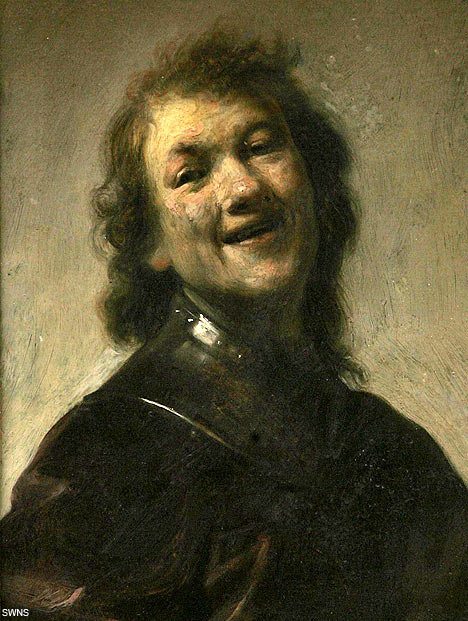I spent part of my first “British Restoration and 18th Century Couples Comedy class talking about “what is laughter?” The period features some of literature’s comic masterpieces and I wanted to give my students some theories that will help them unlock the meaning of comedies by Wycherley, Behn, Goldsmith, and Sheridan; novels by Fielding, Burney, and Austen; and poetry by Wilmot, Montagu, and Pope.
We started with Hobbes’ theory of laughter. Hobbes, of course, is famous for his vision of humans engaged in a war “of every man against every man.” According to Hobbes, without some kind of regulating authority—the Leviathan—our loves would be “solitary, poor, nasty, brutish, and short.”
Hobbes’ theory of laughter flows from this bleak vision. As he sees it, we laugh to assert our own superiority over others:
Men laugh often (especially such as are greedy of applause from every thing they do well) at their own actions performed never so little beyond their own expectation; as also at their own jests: and in this case it is manifest, that the passion of laughter proceedeth from a sudden conception of some ability in himself that laugheth. Also men laugh at the infirmities of others, by comparison of which their own abilities are set off and illustrated. Also men laugh at jests, the wit whereof always consisteth in the elegant discovering and conveying to our minds some absurdity or another. And in this case also the passion of laughter proceedeth from the sudden imagination of our own odds and eminence; for what is else the recommending ourselves to our own good opinion, by comparison with another man’s infirmities or absurdity?
Hobbes wrote Leviathan in the late 1640’s in the midst of England’s Puritan-Cavalier civil war, which helps account for its darkness. It is very useful for charting some of the dynamics in Rochester’s poetry and plays like Country Wife and The Rover, where laughter often comes at someone else’s expense.
When the times became less tumultous, theories of comedy became more benign. In 1711 Anthony Ashley Cooper, the Earl of Shaftesbury, examined the raillery that he and his friends engaged in. He appears to be directly refuting Hobbes’ notion that raillery is designed to assert superiority in a savage and barbaric contest. Instead, Shafesbury’s image is one of good manners and good humor:
[I]n private society. . . .where friends meet knowingly, and with the actual intention of exercising their wit and looking freely into all subjects, I see no basis for anyone to claim to be offended at the way of raillery and humour, which is the very life of such conversations—the only thing that makes good company, and frees it from the formality…
…Wit framed by good manners can’t hurt any cause or interest that I care about; and philosophical speculations, managed in a civilised way, surely can’t ever make mankind more unsociable or uncivilized. That’s not the direction from which I can expect an invasion of savageness and barbarity.
Shaftesbury’s sensibility is more akin to the good-humored comedy of Pope’s Rape of the Lock.
My class pointed out that Shaftesbury doesn’t entirely refute Hobbes. After all, what if this tight group of aristocratic friends is making jokes at the expense of some other group. Maybe it’s not every man vs. every man but insiders vs. outsiders, tribe vs. tribe. This, after all, is how racial and ethnic jokes work.
Like Hobbes, Freud saw hostility as a dimension of laughter. In Jokes and Their Relation to the Unconscious he says that laughter arises out of whatever we push under. He is most famous for talking about sex, of course, but he also saw aggression entering in. Perhaps we push under our natural hostility so that we can all get along—we are socialized to be polite or politically correct—but the energy required to repress our hostility needs venting, which comes in the form of laughter. That’s why jokes, as the late Joan Rivers never ceased pointing out, are necessarily offensive.
Mikhail Bakhtin, however, has a very different view of laughter. A fan of Rabelais and Dickens, he sees laughter as going where serious literature is afraid to tread and, in the process, uncovering essential truths:
The Renaissance conception of laughter can be roughly described as follows: Laughter has a deep philosophical meaning, it is one of the essential forms of the truth concerning the world as a whole, concerning history and man; it is a peculiar point of view relative to the world; the world is seen anew, no less (and perhaps more) profoundly than when seen from the serious standpoint. Therefore, laughter is just as admissible in great literature, posing universal problems, as seriousness. Certain essential aspects of the world are accessible only to laughter.
Drawing on these theories of laughter, one could argue that there are two kinds of laughter: generous laughter and mean-spirited laughter. Hobbes and Freud, two pessimists about human nature, see laughter as combative. Shaftesbury and Bakhtin, optimists, see laughter as communal and supportive. Which theory you find more compelling may come down to the kind of person you are.


